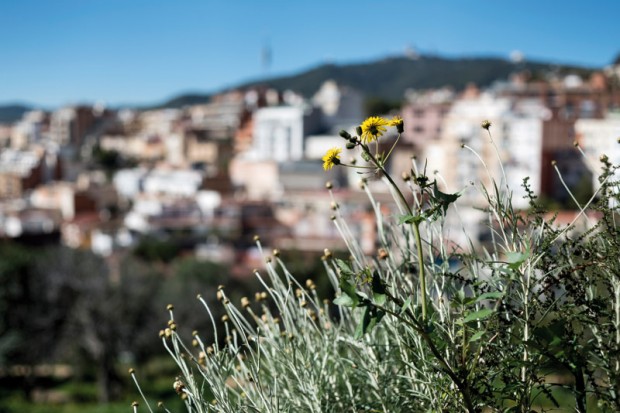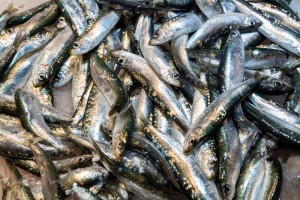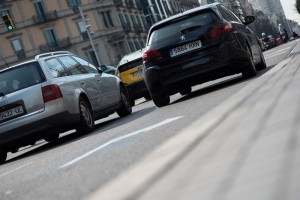Taking a positive view of city smells opens the door to considering them as an element of urban marketing. Deodorising cities and making them identical on an olfactory level – with the same smells everywhere – is one of the results of modern town planning, which insists on stripping public spaces of any emotion.

Plants in Park Güell, which, along with Montjuïc and Ciutadella, is where the scents of earth and vegetation are concentrated.
Photo: Dani Codina
If you were to close your eyes and put plugs in your ears, the only clues as to where you are would come through your nostrils. You can smell the exhaust fumes. The whiff of mass-produced french fries from a fast-food joint. A lady’s scent as she passes by. And the odour of the same chain of clothes shops where you bought the jeans you’re wearing today.
As you remove the blindfold and earplugs, you discover that you’re on Passeig de Gràcia. A minute before, they could just as easily have told you that you were on a shopping street in any other European city and you would have believed it.
Our cities have been deodorised. They have become, in terms of smells, neutral and sterile. And this is not a new phenomenon. It goes back to the 19th century and the hygiene movement that denounced the lack of sanitation and hygiene in industrial towns. Since then, in Western cities, even smells that are not necessarily considered unpleasant have been given negative connotations and ‘managed’ in order to remove them. Moreover, as a result of globalisation, all our cities now have the same types of shops and businesses, bringing with them the same smells and turning our urban areas into clones from an olfactory perspective.
The deodorisation and cloning of cities are the result of modern town planning which sets out to “strip public spaces of any emotion”, so that they become “amorphous”. So says Joan Nogué, Professor of Geography at the University of Girona and, until recently, Director of the Catalonia Landscape Observatory (OPC). As a reaction to globalisation, he goes on, there has been a paradigm shift based on “a return to place, in other words, to a portion of space with its own idiosyncrasies from which we make sense of the world”. That could be a school, a square, a tree, a wine cellar, the curve of a highway, “tiny anodyne pieces of the city” that get filled with meaning and “that embody people’s experience and aspirations, evoke memories and express diverse thoughts, ideas and emotions”, and to which we feel a deep connection. And in this interface between the physical space and our emotions, our senses play a key role.
The most powerful sense
In order to travel through time and space, and delve into in our memory, there’s no need for a DeLorean fitted with a flux capacitor, nor for Dr. Who’s tardis or H. G. Wells’s time machine. As Proust might say, all you need to transport you back to your childhood is to taste a madeleine dipped in a cup of tea or a linden flower infusion. Or perhaps to bump into someone wearing the same aftershave as your grandfather for you to miss him. Or to get a whiff of a sweet, ripe mango like the ones you ate when you were in Brazil for to be able to imagine that you’re on holiday, lying on a white sandy beach.
Our sense of smell can evoke memories and emotions more than any other sense, and this is simply because smells are connected to our limbic system, the most primitive part of our brain, which regulates our emotions and constructs our memory.
Although it so important to the way we experience the world, smell has historically been the sense most derided by western science and philosophy. Since the birth of philosophy in ancient Greece, some 2,500 years ago, sight and hearing have come to be considered the noblest senses; first, because they were associated with the mind and the spirit; and second, because they could be objectively quantified and, therefore, allowed us to interpret reality in a rational manner. Touch, smell and taste, on the other hand, were associated with the body and our most primal instincts – they served to manage our physiological needs, like eating and reproduction, and to ensure our survival – and they produced subjective sensations that could not be measured.
This hierarchy of the senses is also obvious in our urban spaces. In the West, smells are rarely taken into account in urban management. Instead, they are viewed “in terms of control and management – separation, deodorisation, masking and scenting – but not with the aim of preserving and celebrating smells that people like”, said Victoria Henshaw, a lecturer in urban planning and design at the University of Sheffield and author of Urban smellscapes (2013), in a quote printed in her obituary by The Guardian.
But this relationship to smells is very different in eastern cultures, where they are seen as urban assets that should be preserved and enhanced. In 2001 in Japan, the Department for the Environment put out a call for people to choose the five hundred sites in the country that should be preserved for their olfactory qualities. Among those selected were the sea mist that bathes the Kushiro coast or the smell of glue in the Koriyama alleyways, which are lined with doll-making workshops.

Sardines at a fish stall in La Boqueria market, one of the main places from which food smells emanate.
Photo: Dani Codina
A positive view of urban smells, as Henshaw suggests, opens the door to considering them as an element that can be used in urban marketing. Just as clothing multinationals and luxury hotel chains use olfactory marketing to build their brand, one could do the same thing in different parts of the city, provided that it was possible to do without using artificial aromas but by respecting and reinforcing the ones already there.
Given this resurgence of interest in place mentioned by Joan Nogué, and because urban smells make a vital contribution to building our collective identity of place, we should also try to incorporate positive urban smells into our city planning. “Our nose is like a ‘big data’ machine that can capture up to a trillion smells, a tiny proportion of which are managed by local authorities, maybe between ten and fifty, and they are normally negative ones”, explains Daniele Quercia, a researcher at the Nokia Bell Lab at Cambridge University. The reason that the other smells are neglected is because “they are very difficult to detect”, partly because they are subjective and ephemeral, and that is “the main obstacle to incorporating them into urban planning”.
Researchers have tried to measure smells in various ways – with trumpet-shaped noses that measure aspects such as intensity and duration, online smell maps using crowd-sourced data and smell-walks for small groups – but they have not been effective because they require large-scale public involvement.
From pituitary glands to planning
“Stop! Can you smell something?”
These must be the two phrases that Kate McLean, doctoral student at London’s Royal College of Art, uttered the most often, as she gathered data for her Ph.D thesis, which consists in drawing smell maps of cities based on human perception. Kate McLean has conducted several ‘smell-walks’ in cities such as Barcelona, Singapore, London and New York, during which she invites participants to sniff their way along the streets and describe the aromas they detect. In the initial phase, the results are illustrated through maps painted in watercolour, with the colours indicating whether the smells are pleasant or not, while the size of the blotch pointed to the intensity and duration of the odour. At the same, McLean records in an Excel file the vocabulary used by the participants to describe the smells they detected, in real time, during their walk. Words such as “vomit”, “lawn” or “metro” are quite common, although now and again, she says with a smile, she is given more unusual descriptions such as “patxaran” (a liquor akin to sloe gin, typical of the Basque and other northern regions of Spain) and “cigar”, as someone from Pamplona recorded, or the whiff of dark, deep “secrets”, as someone described it on a night walk in Singapore.

The smell of pollution dominates in certain areas that are criss-crossed by major urban roads.
Photo: Dani Codina
One of the results of McLean’s data collection is a vocabulary of 285 terms used to describe the smells of the city, which has served as a basis for a research project led by Daniele Quercia and conducted in several cities, including Barcelona. The 285 terms have been cross-referenced with Twitter tags and texts that accompany geo-referenced photographs on Flickr and Instagram. This has led to maps that can be drawn without the need for public involvement and that could potentially be used as a tool for incorporating smells into urban planning and monitoring them.
For Barcelona, the project used 74,381 Flickr photos, 5,637 Instagram photos and 3,915 tweets. The resulting smell map reveals that animal smells are concentrated at Barcelona Zoo; food smells at La Boqueria market; plant and soil smells in Montjuïc, Ciutadella Park and Park Güell; and pollution smells on Avinguda Diagonal, Ronda Litoral, Travessera de Dalt, Plaça de les Glòries and Gran Via.


